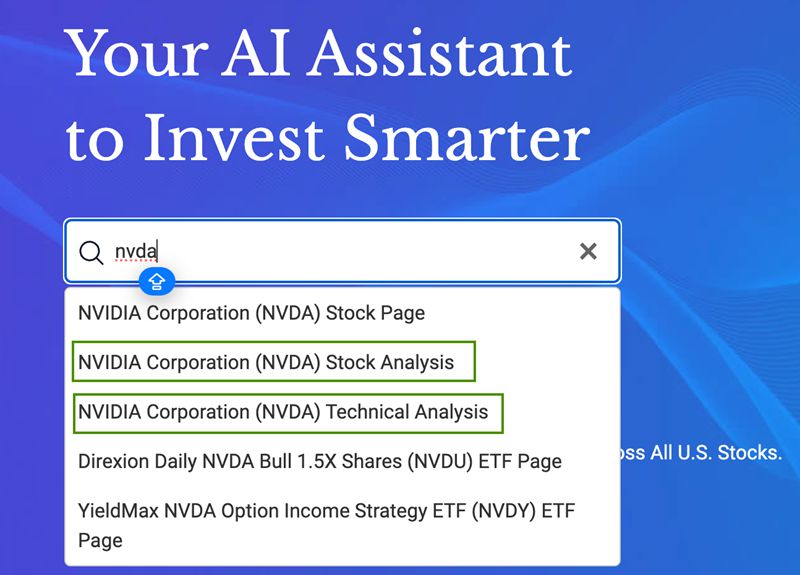20 Great Ways For Picking AI Stock Predicting Sites
20 Great Ways For Picking AI Stock Predicting Sites
Blog Article
Top 10 Tips To Evaluate The Strategy Customization Of Ai Stock Trading Platforms
It is crucial to remember that AI trading platforms with predictive analysis of stocks can provide users with the ability to customize their platform to meet their goals in trading and risk tolerances as well as market conditions. Platforms that offer an array of customizable options will improve your trading performance. Here are the best 10 ways to determine the capacity of platforms to tailor their strategies:
1. Evaluate Pre-Built Strategy Templates
Varieties of Templates: Find out whether the platform you are using has templates pre-built for different trading styles (e.g. Day Trading and Swing Trading, as well as Long-Term Investing).
User-friendliness: Consider the ease of use required to apply and alter these templates to suit your requirements.
Performance history: Determine whether the platform has historical performance data for pre-built strategies.
2. Review the effectiveness of Custom Strategy Creation
Drag-and-drop tools: Choose platforms with drag-and-drop interfaces that permit you to quickly create customized strategies.
Coding Options: If you are an advanced user, be sure that the platform can support custom coding.
Flexibility - Ensure that the platform you select permits you to set rules for entry and exit, as well as parameters to manage risk, and other essential aspects of your strategy.
3. Check for Backtesting Capabilities
Historical data: Ensure that the platform has sufficient historical data available to backtest strategies.
Modifiable parameters - Make sure that you can change parameters (e.g. timeframes, indicators) while back-testing.
Performance metrics: Determine whether the platform has specific performance metrics, for example, win rate (e.g. Sharpe ratio) drawdown, win rate, and various other metrics, for strategies that have been back-tested.
4. Evaluate Real-Time Strategy Testing
Simulation or paper trading Check that the platform supports paper trading modes that let you try out trading strategies in real time without risking any money.
Live testing You can test your strategies in live markets with tiny amounts of capital in order to assess their effectiveness.
Real-time adjustments: Determine whether strategies can be modified in real-time based on market conditions.
5. Integrate Integration and Technical Indicators
Verify if there's an indicator library.
Custom indicators: Make sure you can import or create custom indicators for your strategies.
Combination of indicators: Look whether the platform supports combining multiple indicators for more complex strategies.
6. Check for Risk Management Tools
Stop-loss/take-profit: Ensure the platform allows you to set stop-loss and take-profit levels within your strategies.
Size of the position: See whether you are able to define the rules for sizing your position (e.g. Fixed amount, percentage of your portfolio) to reduce the risk.
Risk-reward rate: Determine if the platform permits setting risk-reward rates specific to specific strategies or trades.
7. Evaluate Multi-Asset Strategy Support
Asset classes: Verify that the platform provides strategies for multiple asset classes.
Cross-asset strategies: See whether you can develop strategies that involve multiple types of assets (e.g. pairings trading, hedging).
Market coverage: Make sure the platform is covered by markets you're in (e.g. US and international markets and copyright and so on.).
8. Review Automation and Execution
Automated trading. Ensure the platform supports automated execution based on predefined strategies.
Order types: Check whether the platform supports different kinds of orders (e.g., limit, market, stop) for strategy execution.
Latency: Determine if the platform can execute trades with minimal latency especially for high-frequency strategies.
9. Take a look at the Strategy Optimization Tools
Parameter optimization - Ensure that the platform includes tools to optimize your strategy parameters.
Machine learning integration: Verify whether the platform is using machine learning for refinement or optimization of strategies.
Scenario Analysis: Determine if the platform supports testing strategies in different market scenarios (e.g. bull or bear and volatile).
10. Review Community Support and Feedback from Users
Feedback from users: Use reviews from users to assess the efficacy of the platform for customizing strategies.
Community forums: See if the platform has an active community of users who can discuss and share their custom strategies.
Support resources: Ensure that the platform provides tutorials, webinars, or other documentation that can help users develop and improve strategies.
Bonus Tips:
Trial period for free: You are able to try out the customizable options of the platform by using the demo or trial.
Scalability - Ensure the platform you choose is able to adapt to your changing trading strategies.
Customer Support: Make sure that the platform has support for any issues related to the strategy or questions.
These tips will help you assess the options for customization of AI trading platforms which analyze and predict the market. So you can select one that is compatible with your objectives in trading which allows you to refine and implement your strategies. A platform with strong customization options can empower users to be able to change market conditions and boost the performance of your trading. Check out the most popular her latest blog for ai copyright trading bot for more info including incite ai, ai trading platform, best ai trading platform, ai trading platform, best ai copyright trading bot, ai trading, invest in ai stocks, ai trader, best ai copyright trading bot, chart ai trading and more.
Top 10 Tips To Evaluate The Risk Management Of Ai Stock Forecasting/Analyzing Trading Platforms
Any AI trading platform that predicts or analyzes stocks has to include risk management which is vital to safeguard your capital and minimizing losses. A platform that has robust risk management tools can assist you in navigating turbulent markets and make informed decisions. Below are the top ten tips to evaluate the risk management capabilities of these platforms.
1. Examine Stop-Loss and Take Profit Features
Customizable levels: Ensure the platform lets you determine take-profit and stop-loss limits for individual trades or strategies.
Find out if the platform allows for trailing stops. They will automatically adjust themselves as markets move in your favor.
If the platform provides stop-loss orders that guarantee the position will be closed to the amount specified in volatile markets, you can be confident of a profitable trade.
2. Assessment Position Sizing Instruments
Fixed amount. Be sure to have the option of defining your positions' sizes as the fixed dollar amount.
Percentage: Determine if you are able to define your position sizes as percentages of the total value of your portfolio. This will enable you to manage risk proportionally.
Risk-reward: Check if your platform lets you set risk-reward for each trade or strategy.
3. Look for Diversification support
Multi-asset trading: Ensure the platform allows trading across multiple asset classes (e.g. stocks, ETFs, options, forex) to help diversify your portfolio.
Sector allocation: Check whether the platform has tools for monitoring and managing exposure to sectors.
Geographic diversification: Make sure that the platform you trade on allows international markets to spread risk geographically.
4. Evaluating margin and leverage controls
Margin requirements: Ensure that the platform clearly outlines any margin requirements for trading leveraged.
Make sure your platform lets you to limit leverage to limit risk exposure.
Margin calls - Examine to see if your platform notifies you of margin calls promptly. This will prevent liquidation.
5. Evaluation of Risk Analytics and Reporting
Risk metrics: Ensure that the platform provides important risk indicators to your portfolio (e.g. Value at Risk (VaR) Sharpe ratio, and drawdown).
Scenario Analysis: Check whether your platform has the capability to simulate different market scenarios in order to evaluate the risk.
Performance reports: Make sure the platform provides you with detailed information on the performance of your investments, including returns that are risk adjusted.
6. Check for Real-Time Risk Monitoring
Portfolio monitoring. Be sure your platform can track in real-time the risk of your portfolio.
Alerts and notifications. Ensure that the platform sends out real-time alerts when certain risk-related events occur (e.g. margin breaches and triggers for stop-loss orders).
Risk dashboards - Check to see if the platform you are using comes with customizable risk dashboards. This will provide you with more information about the risks that you face.
7. Tests of Backtesting, Stress Evaluation
Test for stress: Ensure whether the platform allows you to stress-test your portfolios or strategies during extreme market conditions.
Backtesting Check to see if your platform supports backtesting with historical data for assessing risk and performance.
Monte Carlo simulations: Verify that the platform is using Monte Carlo simulations to model possible outcomes and determine the the risk.
8. Assess Compliance with Risk Management Regulations
Compliance with Regulations: Check the platform's compliance with the relevant Regulations on Risk Management (e.g. MiFID II for Europe, Reg T for the U.S.).
Best execution: Check if the platform follows best execution practices. This will ensure that trades are executed at the best price available to minimize slippage.
Transparency Check the platform's transparency and transparency in risk disclosure.
9. Verify that the risk parameters are controlled by the user.
Custom risk rules - Be sure the platform permits for you to define your own risk management rules.
Automated Risk Controls: Check if the platform is able to automate the enforcement of the risk management policy in accordance with predetermined parameters.
Manual overrides - Check whether your platform lets you manually bypass automated risk controls.
Review of User Feedback and Case Studies
User feedback: Review the opinions of users to assess the platform's capability to manage the risks.
Case studies and testimonials: These will highlight the risk management capabilities of the platform.
Community forums - Look for yourself if the platform has a community for users that is active, and where traders can discuss their strategies for managing risk.
Bonus Tips:
Free Trial: Test the features of the platform for risk management in real-world scenarios.
Support for customers: Make sure the platform offers robust support for risk management-related issues or questions.
Educational resources: Find out whether you can find any educational materials available on best practices in managing risk.
With these suggestions, you can determine the capabilities of AI stock prediction/analyzing trading platform to manage risks. This will ensure you pick a system that is safe for your capital, and minimizes any losses that could occur. To stay out of unstable markets and to achieve long-term trading successes, you need robust risk management software. Have a look at the top rated inciteai.com AI stock app for site info including stock analysis websites, invest in ai stocks, artificial intelligence stocks, chart ai for trading, best ai copyright, ai stock price prediction, investing ai, best free copyright trading bot, best ai stocks to invest in, best ai stock and more.